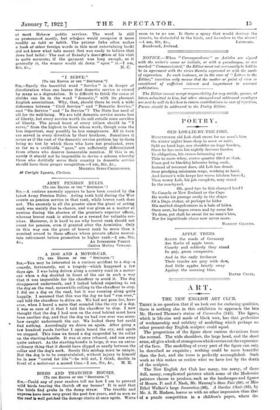ART.
THE NEW ENGLISH ART CLUB.
MERE is no question that if we look out for enduring qualities, there is nothing else in this exhibition to approach the late Mr. Havard Thomas's statue of Cassandra (145). The figure, which is life-size and made of black wax, has that perfection of workmanship and subtlety of modelling which perhaps no other present-day English sculptor could equal.
The proportions of the figure show curious deviations from the normal. The wide shoulders, the large head, and the short arms, all give a look of strangeness which carries out the expression of the face. The modelling of every part of the figure can only be described as exquisite ; nothing could be more beautiful than the feet, and the torso is perfectly accomplished. Such work as this makes us realize what we have lost by the death of the sculptor.
The New English Art Club has many, too many, of those dull, messy, complicated pictures which some of the Modernist painters choose to produce, such as the landscapes and figures of Messrs. P. and J. Nash, Mr. Hannay's Stow Fair (68), or Miss Ethel Walker's large Invocation (96). A Garden Chair (82), by Mr. A. H. Hudson, leaves us with no other impression than that I of a puzzle competition in a children's paper, where the
important object is concealed amid a tangle of irrelevant things..
It is a. pleasure to turn from such work to a picture like Mr. F. H. S. Shepherd's Ariadne (14), with its exceedingly beautiful pale blue sky and sea, dark headland and luminous flesh. The picture is interesting, too, for the unusual view of a seated figure, with the back partly turned away. There are two land- scapes by Mr. C. H. C. Baker (81 and 179), both of Italian lake country, which by their thoughtful simplification and good colour stand out from their surroundings. More remarkable still for these same qualities is Mr. Unwin's large water-colour of the Schre,ckhorn and Finsteraarhorn (182). Here we really feel that the mountains are great, solid things, and that their forms have been carved by the eternal forces of rain and frost, and out of these forms has been constructed a living work of art. Such a drawing as this is the justification of the many failures and experiments which have been made in recent years in the attempt to raise landscape painting out of the ditch of stupid naturalistic representation.
Another picture which appeals to us on the same lines, though with less of abstract qualities, is Sir C. J. Holmes' Tebay Fells (98); the colour as well as the form is austere and dignified, and there is a fine sweep of line in his Sea Wall (77).
Mr. Wilson Steer shows an academic study of an undraped female figure which is very beautiful in colour and quality of paint surface, and is exactly suited to the very beautiful old Italian silver frame.
Mr. Clausen's Michael (105) is a beautiful portrait of a little boy with a house of cards beside him, all painted in silvery tones. Mr. Munro Summer's Anemones (118) and Mr. Meninsky's Still Life (83) are conspicuous among works of their class.
H. S.











































 Previous page
Previous page